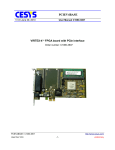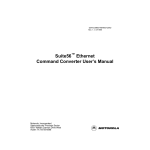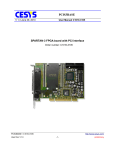Download XEM6010 User`s Manual
Transcript
Opal Kelly XEM6010 User’s Manual A compact (75mm x 50mm) integration board featuring the Xilinx Spartan-6 FPGA, High-Speed USB 2.0, and on-board DDR2 memory. The XEM6010 is a compact USB 2.0 FPGA integration module featuring the Xilinx Spartan-6 FPGA, 1 Gb (64 Mx16-bit) DDR2 SDRAM, high-efficiency switching power supplies, and two high-density 0.8-mm expansion connectors. The high-speed USB 2.0 interface provides fast configuration downloads and PC-FPGA communication as well as easy access with our popular FrontPanel application and SDK. A flexible, multiple-output PLL is also provided on-board.. Software, documentation, samples, and related materials are Copyright © 2010-2015 Opal Kelly Incorporated. Opal Kelly Incorporated Portland, Oregon http://www.opalkelly.com All rights reserved. Unauthorized duplication, in whole or part, of this document by any means except for brief excerpts in published reviews is prohibited without the express written permission of Opal Kelly Incorporated. Opal Kelly, the Opal Kelly Logo, and FrontPanel are trademarks of Opal Kelly Incorporated. Linux is a registered trademark of Linus Torvalds. Microsoft and Windows are both registered trademarks of Microsoft Corporation. All other trademarks referenced herein are the property of their respective owners and no trademark rights to the same are claimed. Revision History: Date Description 20110301 Initial release. 20110317 Minor updates. 20110406 Added note and reference regarding LVDS output restriction for Spartan-6. 20110818 Fix minor typo in pinout table. L59N_1 changed to L49N_1 20110926 Added sections on MUXSEL and I2C_SCL / I2C_SDA treatment. 20120216 Added another table to the BRK6110 connections section. 20121128 Added key storage information for newer PCB revision. 20140402 Added remarks about Pins reference. 20141202 Fix JP3-7 reference in the XEM3050 Migration information. 20150303 Added additional Pins information. Contents Introducing the XEM6010 . . . . . . . . . . . . . . . . . . . . . . . 5 PCB Footprint. . . . . . . . . . . . . . . . . . . . . . . . . . . . . . . . . . . . . 5 BRK6110 Breakout Board. . . . . . . . . . . . . . . . . . . . . . . . . 5 Functional Block Diagram. . . . . . . . . . . . . . . . . . . . . . . . . . . . 6 FPGA . . . . . . . . . . . . . . . . . . . . . . . . . . . . . . . . . . . . . . . . . . . 6 Power Supply. . . . . . . . . . . . . . . . . . . . . . . . . . . . . . . . . . . . . 6 DC Power Connector. . . . . . . . . . . . . . . . . . . . . . . . . . . . 7 High-Speed USB 2.0 Interface. . . . . . . . . . . . . . . . . . . . . . . . 7 On-board Peripherals. . . . . . . . . . . . . . . . . . . . . . . . . . . . . . . 7 Cypress CY22393 PLL. . . . . . . . . . . . . . . . . . . . . . . . . . . 7 128-MByte Word-Wide DDR2 Synchronous DRAM. . . . 7 Serial Flash Memory . . . . . . . . . . . . . . . . . . . . . . . . . . . . 7 LEDs. . . . . . . . . . . . . . . . . . . . . . . . . . . . . . . . . . . . . . . . . 7 Expansion Connectors. . . . . . . . . . . . . . . . . . . . . . . . . . . . . . 7 FrontPanel Support. . . . . . . . . . . . . . . . . . . . . . . . . . . . . . . . . 8 Programmer’s Interface. . . . . . . . . . . . . . . . . . . . . . . . . . 8 Applying the XEM6010 . . . . . . . . . . . . . . . . . . . . . . . . . 9 Powering the XEM6010 . . . . . . . . . . . . . . . . . . . . . . . . . . . . . 9 Power Budget. . . . . . . . . . . . . . . . . . . . . . . . . . . . . . . . . . 9 Example XEM6010-LX150 FPGA Power Consumption. . 10 Supply Heat Dissipation (IMPORTANT!!). . . . . . . . . . . . . 10 Host Interface. . . . . . . . . . . . . . . . . . . . . . . . . . . . . . . . . . . . . 11 MUXSEL. . . . . . . . . . . . . . . . . . . . . . . . . . . . . . . . . . . . . . 11 I2C Connections. . . . . . . . . . . . . . . . . . . . . . . . . . . . . . . . 11 SPI Flash . . . . . . . . . . . . . . . . . . . . . . . . . . . . . . . . . . . . . . . . 11 FlashLoader Sample . . . . . . . . . . . . . . . . . . . . . . . . . . . . 12 LEDs. . . . . . . . . . . . . . . . . . . . . . . . . . . . . . . . . . . . . . . . . . . . 12 DDR2 SDRAM. . . . . . . . . . . . . . . . . . . . . . . . . . . . . . . . . . . . 12 Clock Configuration (Source Synchronous). . . . . . . . . . . 13 Memory Controller Blocks . . . . . . . . . . . . . . . . . . . . . . . . 13 MIG Settings. . . . . . . . . . . . . . . . . . . . . . . . . . . . . . . . . . . 13 JTAG. . . . . . . . . . . . . . . . . . . . . . . . . . . . . . . . . . . . . . . . . . . . 14 Key Memory Storage (LX150 only, PCB revision 20120510 and newer) Volatile Encryption Key Storage (Vbatt). . . . . . . . . . . . . . 14 Non-Volatile Encryption Key Storage (eFUSE) . . . . . . . . 15 Expansion Connectors. . . . . . . . . . . . . . . . . . . . . . . . . . . . . . 15 JP2. . . . . . . . . . . . . . . . . . . . . . . . . . . . . . . . . . . . . . . . . . 16 JP3. . . . . . . . . . . . . . . . . . . . . . . . . . . . . . . . . . . . . . . . . . 16 Setting I/O Voltages. . . . . . . . . . . . . . . . . . . . . . . . . . . . . 16 Considerations for Differential Signals. . . . . . . . . . . . . . . 16 BRK6110 Breakout Board. . . . . . . . . . . . . . . . . . . . . . . . . . . . 17 Pins. . . . . . . . . . . . . . . . . . . . . . . . . . . . . . . . . . . . . . . . . . . . . 17 Toolbar. . . . . . . . . . . . . . . . . . . . . . . . . . . . . . . . . . . . . . . 17 Pin Lists . . . . . . . . . . . . . . . . . . . . . . . . . . . . . . . . . . . . . . 18 Filters. . . . . . . . . . . . . . . . . . . . . . . . . . . . . . . . . . . . . . . . 18 Search . . . . . . . . . . . . . . . . . . . . . . . . . . . . . . . . . . . . . . . 18 14 XEM6010 User’s Manual Export (PDF, CSV, Constraints Files). . . . . . . . . . . . . . . . 18 Peripherals. . . . . . . . . . . . . . . . . . . . . . . . . . . . . . . . . . . . 19 Migrating from the XEM3010 to the XEM6010. . . . . . . . . . . . 20 Four I/O Banks → Two I/O Banks. . . . . . . . . . . . . . . . . . . 20 32 MiB SDR SDRAM → 128 MiB DDR2 SDRAM. . . . . . 20 Two Pushbuttons → No Pushbuttons. . . . . . . . . . . . . . . . 20 Expansion Connector Differences. . . . . . . . . . . . . . . . . . 20 JTAG Connectivity. . . . . . . . . . . . . . . . . . . . . . . . . . . . . . 20 Migrating from the XEM3050 to the XEM6010. . . . . . . . . . . . 21 Four I/O Banks → Two I/O Banks. . . . . . . . . . . . . . . . . . . 21 64 MiB SDR SDRAM → 128 MiB DDR2 SDRAM. . . . . . 21 Synchronous SRAM Removed . . . . . . . . . . . . . . . . . . . . 21 Expansion Connector Differences. . . . . . . . . . . . . . . . . . 21 JTAG Connectivity. . . . . . . . . . . . . . . . . . . . . . . . . . . . . . 21 XEM6010 Mechanical Drawing. . . . . . . . . . . . . . . . . . . 22 BRK6110 Mechanical Drawing. . . . . . . . . . . . . . . . . . . . 23 XEM6010 Quick Reference. . . . . . . . . . . . . . . . . . . . . . 24 XEM6010 Quick Reference. . . . . . . . . . . . . . . . . . . . . . 25 4 www.opalkelly.com XEM6010 User’s Manual Introducing the XEM6010 The XEM6010 is a compact FPGA board featuring the Xilinx Spartan-6 FPGA and high-speed USB 2.0 connectivity. Designed as a full-featured integration system, the XEM6010 provides access to over 110 I/O pins on its 484-pin Spartan-6 device and has a 128-MiByte DDR2 SDRAM available to the FPGA. The XEM6010 is designed for medium-sized FPGA designs with a wide variety of external interface requirements. PCB Footprint A mechanical drawing of the XEM6010 is shown at the end of this manual. The PCB is 75mm x 50mm with four mounting holes (M2 metric screws) spaced as shown in the figure. These mounting holes are electrically isolated from all signals on the XEM6010. The two connectors (USB and DC power) overhang the PCB by approximately 4mm in order to accommodate mounting within an enclosure. The XEM6010 has two high-density 80-pin connectors on the bottom side which provide access to many FPGA pins, power, and JTAG. BRK6110 Breakout Board A simple breakout board (the BRK6110) is provided as an optional accessory to the XEM6010. This breakout board provides DC power and easy access to the high-density connectors on the XEM6010 by routing them to lower-density 2mm-spaced thru-holes. The breakout board also provides a convenient reference for building boards that will mate to the XEM6010. Opal Kelly reserves the right to change the form-factor and possibly pinout of the BRK6110. Therefore, unlike the XEM6010, it is not intended or recommended for production integration. www.opalkelly.com 5 XEM6010 User’s Manual Full schematics and Gerber artwork files for the BRK6110 are provided free of charge. If your application depends on the existing form-factor, you may reproduce this board from these documents. A mechanical drawing of the BRK6110 is also shown at the end of this document. Functional Block Diagram Flash 32 Mib USB 2.0 USB Micro (CY68013A) Spartan-6 FPGA XC6SLX45-2FGG484 Host Interface Bus PLL (CY22393) DDR2 SDRAM 128 MiB or XC6SLX150-2FGG484 3 PLL CLKs 60 I/O 1 PLL CLK 60 I/O 8 LEDs Samtec Expansion Connector 1 PLL CLK Samtec Expansion Connector FPGA The XEM6010 is offered in two variants. These two variants are identical except for the FPGA provided. The table below lists some of the differences between the two devices. Please consult the Xilinx documentation for a more thorough comparison. Feature XEM6010-LX45 XEM6010-LX150 FPGA XC6SLX45-2FGG484C XC6SLX150-2FGG484C Slice Count 6,822 23,038 D Flip-Flops 54,576 184,304 Distributed RAM 401 Kib 1,355 Kib Block RAM 2,088 Kib 4,824 Kib DSP Slices 58 180 Clock Management Tiles 4 6 Power Supply The XEM6010 is designed to be operated from a 5-volt power source supplied through the DC power jack on the device or the expansion connectors on the bottom of the device. This provides power for the three high-efficiency switching regulators on-board to provide 3.3v, 1.8v and 1.2v. 0.9v is derived from the 3.3-volt supply using a small low-dropout (LDO) regulator for use as a DDR2 termination voltage. Each of the three switching regulators can provide up to 2A of current. 6 www.opalkelly.com XEM6010 User’s Manual DC Power Connector The DC power connector on the XEM6010 is part number PJ-102AH from CUI, Inc. It is a standard “canon-style” 2.1mm / 5.5mm jack. The outer ring is connected to DGND. The center pin is connected to +VDC. High-Speed USB 2.0 Interface The XEM6010 uses a Cypress CY7C68013A FX2LP USB microcontroller to make the XEM a USB 2.0 peripheral. As a USB peripheral, the XEM is instantly recognized as a plug and play peripheral on millions of PCs. More importantly, FPGA downloads to the XEM happen blazingly fast, virtual instruments under FrontPanel update quickly, and data transfers are much faster than the parallel port interfaces common on many FPGA experimentation boards. On-board Peripherals The XEM6010 is designed to compactly support a large number of applications with a small number of on-board peripherals. These peripherals are listed below. Cypress CY22393 PLL A multi-output, triple-PLL clock generator can provide up to five clocks, three to the FPGA and another two to the expansion connectors JP2 and JP3. The PLL is driven by a 48-MHz signal output from the USB microcontroller. The PLL can output clocks up to 150-MHz and is configured through the FrontPanel software interface or the FrontPanel API. 128-MByte Word-Wide DDR2 Synchronous DRAM The XEM also includes a 128-MiByte DDR2 SDRAM with a full 16-bit word-wide interface to the FPGA. This SDRAM is attached exclusively to the FPGA and does not share any pins with the expansion connector. The maximum clock rate of the SDRAM is 333 MHz. With the -2 speed grade of the Spartan-6, the maximum clock rate is 312.5 MHz for a supported peak memory bandwidth of 10 Gb/s. The DDR2 SDRAM is a Micron MT47H64M16HR-3:G (or compatible). Serial Flash Memory A 32 Mib serial flash device (Numonyx M25P32-VME6G or equivalent) provides on-board configuration memory for the FPGA as well as general non-volatile storage for your design. LEDs Eight LEDs and are available for general use as debug outputs. Expansion Connectors Two high-density, 80-pin expansion connectors are available on the bottom-side of the XEM6010 PCB. These expansion connectors provide user access to several power rails on the XEM6010, the JTAG interface on the FPGA, and 124 non-shared I/O pins on the FPGA, including several GCLK inputs. The connectors on the XEM6010 are Samtec part number: BSE-040-01-F-D-A. The table below lists the appropriate Samtec mating connectors along with the total mated height. www.opalkelly.com 7 XEM6010 User’s Manual Samtec Part Number Mated Height BTE-040-01-F-D-A 5.00mm (0.197”) BTE-040-02-F-D-A 8.00mm (0.315”) BTE-040-03-F-D-A 11.00mm (0.433”) BTE-040-04-F-D-A 16.10mm (0.634”) BTE-040-05-F-D-A 19.10mm (0.752”) FrontPanel Support The XEM6010 is fully supported by Opal Kelly’s FrontPanel Application. FrontPanel augments the limited peripheral support with a host of PC-based virtual instruments such as LEDs, hex displays, pushbuttons, toggle buttons, and so on. Essentially, this makes your PC a reconfigurable I/O board and adds tremendous value to the XEM6010 as an experimentation or prototyping system. Programmer’s Interface In addition to complete support within FrontPanel, the XEM6010 is also fully supported by the FrontPanel SDK, a powerful C++ class library available to Windows, Mac OS X, and Linux programmers allowing you to easily interface your own software to the XEM. In addition to the C++ library, wrappers have been written for C#, Java, and Python making the API available under those languages as well. Sample wrappers are also provided for Matlab and LabVIEW. Complete documentation and several sample programs are installed with FrontPanel. 8 www.opalkelly.com XEM6010 User’s Manual Applying the XEM6010 Powering the XEM6010 The XEM6010 requires that this supply be clean, filtered, and within the range of 4.5v to 5.5v. This supply must be delivered through the +VDC pins on the two device’s two expansion connectors or the DC power connector.. The expansion bus has several power supply pins, described below: • • • • • • +VDC is provided by an external device to the XEM6010. It must be a clean, filtered supply within the range of +4.5 volts and +5.5 volts. +3.3v is the output of a 2-Amp switching regulator on the XEM6010. +1.8v is the output of a 2-Amp switching regulator on the XEM6010. +1.2v is the output of a 2-Amp switching regulator on the XEM6010. +VCCO0 is the bank-0 I/O voltage to the FPGA. Factory default is +3.3v +VCCO1 is the bank-1 I/O voltage to the FPGA. Factory default is +3.3v Power Budget The table below can help you determine your power budget for each supply rail on the XEM6010. All values are highly dependent on the application, speed, usage, and so on. Entries we have made are based on typical values presented in component datasheets or approximations based on Xilinx power estimator results. Shaded boxes represent unconnected rails to a particular component. Empty boxes represent data that the user must provide based on power estimates. The user may also need to adjust parameters we have already estimated (such as FPGA Vcco values) where appropriate. www.opalkelly.com 9 XEM6010 User’s Manual Component(s) 1.2v 1.8v USB 2.0, PLL 3.3v 320 mW DDR2 600 mW 250 mW FPGA Vccint FPGA Vccaux 250 mW FPGA Vcco3 (DDR2), est. 250 mW FPGA Vcco2 (USB), est. 250 mW FPGA Vcco0,1 Total: Available: 2,400 mW 3,600 mW 6,600 mW Example XEM6010-LX150 FPGA Power Consumption XPower Estimator version 12.3 was used to compute the following power estimates for the Vccint supply. These are simply estimates; your design requirements may vary considerably. The numbers below indicate approximately 70% to 80% utilization. Component Parameters Vccint Clock 150 MHz GCLK - 70,000 fanout 384 mW Clock 100 MHz GCLK - 70,000 fanout 256 mW Logic (DFF) 150 MHz, 70,000 DFFs 380 mW Logic (DFF) 100 MHz, 70,000 DFFs 232 mW Logic (LUT) 150 MHz, 32,000 Combinatorial, 1,000 SR, 1,000 RAM 287 mW Logic (LUT) 100 MHz, 32,000 Combinatorial, 1,000 SR, 1,000 RAM 191 mW BRAM 18-bit, 100 @ 150 MHz, 100 @ 100 MHz 237 mW DSP 150 MHz, 140 slices 78 mW MCB 150 MHz 85 mW Misc. DCM, PLL, etc. 100 mW Total: 2,230 mW Available: 2,400 mW Supply Heat Dissipation (IMPORTANT!!) Due to the limited area available on the small form-factor of the XEM6010 and the density of logic provided, heat dissipation may be a concern. This depends entirely on the end application and cannot be predicted in advance by Opal Kelly. Heat sinks may be required on any of the devices on the XEM6010. Of primary focus should be the FPGA (U10) and SDRAM (U11). Although the switching supplies are high-efficiency, they are very compact and consume a small amount of PCB area for the current they can provide. If you plan to put the XEM6010 in an enclosure, be sure to consider heat dissipation in your design. 10 www.opalkelly.com XEM6010 User’s Manual Host Interface There are 26 pins that connect the on-board USB microcontroller to the FPGA. These pins comprise the host interface on the FPGA and are used for configuration downloads. After configuration, these pins are used to allow FrontPanel communication with the FPGA. If the FrontPanel okHost module is instantiated in your design, you must map the interface pins to specific pin locations using Xilinx LOC constraints. This may be done using the Xilinx constraints editor or specifying the constraints manually in a text file. Please see the sample projects included with your FrontPanel installation for examples. MUXSEL MUXSEL is a signal on the XEM6010 which selects the signal path to the FPGA programming signals D0 and CCLK. When low (deasserted), the FPGA and USB microcontroller are connected. When high (asserted), the FPGA and PROM are connected. In normal USB-programmed operation, JP5 is in the USB position connecting the FPGA and USB microcontroller at all times. This allows USB-based programming of the FPGA and subsequent USB communication with the FPGA design after configuration. In order to allow the SPI to configure the FPGA, JP5 must be in the PROM position.. In order to deassert MUXSEL post-configuration, your design must deassert MUXSEL. This allows the FPGA design to properly startup and allows for communication over USB even after the PROM has configured it. The end result is that your FPGA design should tie HI_MUXSEL to 0. This is the case regardless of how the design was configured (via PROM or USB). For example, in Verilog: assign hi_muxsel = 1’b0; I2C Connections The FPGA on the XEM6010 is attached to the I2C lines from the USB microcontroller. In order to avoid contention with the I2C bus, these lines should be set to high-impedance within your design. If this is not done, FrontPanel may timeout or hang when trying to communicate with the XEM6010, particularly when programming the on-board PLL. The following lines in your UCF (contraints) file will attach pull-ups to the I2C lines: NET “i2c_sda” NET “i2c_scl” LOC = “AB9” LOC = “Y9” | IOSTANDARD=”LVCMOS33” | PULLUP; | IOSTANDARD=”LVCMOS33” | PULLUP; In addition, you will need to set these signals to high-impedance in your HDL. Here is an example of how to do this in Verilog: assign i2c_sda = 1’bz; assign i2c_scl = 1’bz; SPI Flash The SPI flash on the module is a Numonyx M25P32-VME6G or equivalent. It can be programmed (using the FlashLoader sample) with an FPGA configuration bitfile to configure the www.opalkelly.com 11 XEM6010 User’s Manual FPGA on boot. To boot the FPGA from flash, the switch JP5 must be slid to the “PROM” position. To boot the FPGA using FrontPanel, the switch must be slid to the “USB” position. In both cases, FrontPanel communication is available after configuration completes. Flash Pin FPGA Pin C W12 S T5 D AB15 Q Y15 FlashLoader Sample The FlashLoader sample is installed with your FrontPanel installation. It is a simple commandline utility that you can use to program the SPI flash with an FPGA configuration file. Please see the Samples directory for more information. You can also load a configuration file to the Flash using your own HDL, of course. There is nothing special about the way our FlashLoader sample loads the configuration file into the Flash. LEDs There are eight LEDs on the XEM6010. Each is wired directly to the FPGA according to the pin mapping tables at the end of this document. The LED anodes are connected to a pull-up resistor to +3.3VDD and the cathodes wired directly to the FPGA on Bank 2 with a bank I/O voltage of 3.3v. To turn ON an LED, the FPGA pin should be brought low. To turn OFF an LED, the FPGA pin should be at logic ‘1’. DDR2 SDRAM The Micron DDR2 SDRAM is connected exclusively to the 1.8-v I/O on Bank 3 of the FPGA. The tables below list these connections. 12 www.opalkelly.com XEM6010 User’s Manual DDR2 Pin FPGA Pin DDR2 Pin FPGA Pin CK H4 A9 E1 CK H3 A10 G4 CKE D2 A11 C1 CS C3 A12 D1 RAS K5 BA0 G3 CAS K4 BA1 G1 WE F2 BA2 F1 LDQS L3 D0 N3 LDQS L1 D1 N1 UDQS T2 D2 M2 UDQS T1 D3 M1 LDM L4 D4 J3 UDM M3 D5 J1 ODT J6 D6 K2 A0 H2 D7 K1 A1 H1 D8 P2 A2 H5 D9 P1 A3 K6 D10 R3 A4 F3 D11 R1 A5 K3 D12 U3 A6 J4 D13 U1 A7 H6 D14 V2 E3 D15 V1 A8 Clock Configuration (Source Synchronous) The DDR2 clocking is designed to be source-synchronous from the FPGA. This means that the FPGA sends the clock signal directly to the SDRAM along with control and data signals, allowing very good synchronization between clock and data. Memory Controller Blocks Spartan-6 has integrated memory control blocks to communicate with the external DDR2 memory on the XEM6010. This is instantiated using the Xilinx Core Generator (memory interface generator, or MIG) to create a suitable memory controller for your design. You should read and become familiar with the DDR2 SDRAM datasheet as well as MIG and the core datasheet. Although MIG can save a tremendous amount of development time, understanding all this information is critical to building a working DDR2 memory interface. The XEM6010 provides 1.2v as Vccint. According to the memory controller block documentation, the Spartan-6, -2 speed grade can operate memory to 312.5 MHz with this internal voltage. MIG Settings The following are the settings used to generate the MIG core for our RAMTester sample using Xilinx Core Generator. These settings were used with ISE 12.2 and MIG 2.3. Note that settings may be slightly different for different versions of ISE or MIG. www.opalkelly.com 13 XEM6010 User’s Manual Frequency312.5 MHz Memory TypeComponent Memory Part MT47H64M16XX-3 (1Gb, x16) Data Width 16 Enable DQS Enable CHECKED High-temp self-refresh DISABLED Output drive strength Reducedstrength RTT(nominal)50 ohms[default] DCI for DQ/DQS CHECKED DCI for address/control CHECKED ZIO pin Y2 RZQ pin K7 Calibrated Input Selection Yes Class for address/control Class II Debug signals Your option System clock Differential JTAG The JTAG connections on the FPGA are wired directly to the expansion connector JP2 on the XEM6010 to facilitate FPGA configuration and ChipScope usage using a Xilinx JTAG cable. The BRK6110 has these signals connected to a 2-mm header compatible with the Xilinx JTAG cable. Key Memory Storage (LX150 only, PCB revision 20120510 and newer) Note: This information is valid only for PCB revisions 20120510 and newer. The Spartan-6 FPGA supports design security using AES decryption logic and provides two methods for encryption key memory storage. The first is a volatile memory storage supported by an external battery backup supply voltage (Vbatt). The second is a one-time programmable eFUSE. The XEM6310 design supports both types of key storage with user-modification required. For quantity purchases of 50 or more units, please contact Opal Kelly ([email protected]) to discuss factory installation of these components. Volatile Encryption Key Storage (Vbatt) A small lithium rechargeable battery and three support components can be installed to provide Vbatt to the FPGA when the XEM is unpowered. This will preserve the contents of the FPGA’s volatile key storage so long as Vbatt remains over the threshold specified in the Spartan-6 documentation. Please see the Xilinx Spartan-6 FPGA Configuration User Guide (UG380) for more details. Alternatively, Vbatt may be provided through JP2-3. In this case, BT1 should not be installed. The applicable schematic section and components required to support this functionality are shown below. 14 RefDes Manufacturer Manufacturer P/N Comment BT1 Seiko Instruments MS412FE-FL26E 3V, 1mAh lithium battery D10 Micro Commercial BAS40-04-TP Schottky Diode, SOT23 C11 Generic 0.1 μF, SM-0402 Decoupling www.opalkelly.com XEM6010 User’s Manual RefDes Manufacturer Manufacturer P/N R24, R39 Generic 4.7 kΩ, 5%, SM-0402 R41 Generic 0 Ω, SM-0402 Comment Connects Vbatt to JP2-3 Non-Volatile Encryption Key Storage (eFUSE) Non-volatile storage of the encryption key is also possible by programming the Spartan-6 eFUSE via JTAG. Please see the Xilinx Spartan-6 FPGA Configuration User Guide (UG380) for more details. To program the eFUSE, you must first install the components listed in the table below. You must also provide an external resistor (Rfuse) between JP2-12 and GND. The value of this resistor is specified in the Xilinx Spartan-6 Datasheet (DS162) between 1129 Ω and 1151 Ω. RefDes Manufacturer Manufacturer P/N Comment C10 Generic 0.1 μF, SM-0402 Decoupling R40 Generic 0 Ω, SM-0402 Connects FPGA Vfs to +3.3v R42 Generic 0 Ω, SM-0402 Connects FPGA Rfuse to JP2-12 Expansion Connectors Opal Kelly Pins is an interactive online reference for the expansion connectors on all Opal Kelly FPGA integration modules. It provides additional information on pin capabilities, pin characteristics, and PCB routing. Additionally, Pins provides a tool for generating constraint files for place and route tools. Pins can be found at the URL below. http://www.opalkelly.com/pins www.opalkelly.com 15 XEM6010 User’s Manual JP2 JP2 is an 80-pin high-density connector providing access to FPGA Bank 1. Several pins (38, 40, 54, 58, 59, 61, 77, and 79) of this connector are wired to global clock inputs on the FPGA and can therefore be used as inputs to the global clock network. Pin JP2-10 is connected to the Vref pins of Bank 1. Pin mappings for JP2 are listed at the end of this document in the “Quick Reference” section. For each pin, the corresponding board connection is listed. For pins connected to the FPGA, the corresponding FPGA pin number is also shown. Finally, for pins routed to differential pair I/Os on the FPGA, the FPGA signal names and routed track lengths have been provided to help you equalize lengths on differential pairs. JP3 JP3 is an 80-pin high-density connector providing access to FPGA Banks 0 and 1. Several pins (42, 44, 59, 61, 64, 66, 77, and 79) of this connector are wired to global clock inputs on the FPGA and can therefore be used as inputs to the global clock network. Pin mappings for JP3 are listed at the end of this document in the “Quick Reference” section. For each pin, the corresponding board connection is listed. For pins connected to the FPGA, the corresponding FPGA pin number is also shown. Finally, for pins routed to differential pair I/Os on the FPGA, the FPGA signal names and routed track lengths have been provided to help you equalize lengths on differential pairs. Setting I/O Voltages The Spartan-6 FPGA allows users to set I/O bank voltages in order to support several different I/O signalling standards. This functionality is supported by the XEM6010 by allowing the user to connect independent supplies to the FPGA VCCO pins on two of the FPGA banks. By default, ferrite beads have been installed that attach each VCCO bank to the +3.3VDD supply. If you intend to supply power to a particular I/O bank, you MUST remove the appropriate ferrite beads. Power can then be supplied through the expansion connectors. The table below lists details for user-supplied I/O bank voltages I/O Bank Expansion Pins Ferrite Bead 0 JP3-36, 56 FB2 1 JP2-35, 55 FB1 Considerations for Differential Signals The XEM6010 PCB layout and routing has been designed with several applications in mind, including applications requiring the use of differential (LVDS) pairs. Please refer to the Xilinx Spartan-6 datasheet for details on using differential I/O standards with the Spartan-6 FPGA. Note: LVDS output on the Spartan-6 is restricted to banks 0 and 2. LVDS input is available on all banks. For more information, please refer to the Spartan-6 FPGA SelectIO Resources User Guide from Xilinx. 16 www.opalkelly.com XEM6010 User’s Manual FPGA I/O Bank Voltages In order to use differential I/O standards with the Spartan-6, you must set the VCCO voltages for the appropriate banks to 2.5v according to the Xilinx Spartan-6 datasheet. Please see the section above entitled “Setting I/O Voltages” for details. Characteristic Impedance The characteristic impedance of all routes from the FPGA to the expansion connector is approximately 50-Ω. Differential Pair Lengths In many cases, it is desirable that the route lengths of a differential pair be matched within some specification. Care has been taken to route differential pairs on the FPGA to adjacent pins on the expansion connectors whenever possible. We have also included the lengths of the board routes for these connections to help you equalize lengths in your final application. Due to space constraints, some pairs are better matched than others. Reference Voltage Pins (Vref) The Xilinx Spartan-6 supports externally-applied input voltage thresholds for some input signal standards. The XEM6010 supports these Vref applications for banks 0 and 1: For Bank 0, the four Vref pins are routed to expansion connector JP3 on pins 48, 51, 62, and 65. Note that all four must be connected to the same voltage for proper application of input thresholds. Please see the Xilinx Spartan-6 documentation for more details. For Bank 1, the four Vref pins are connected to a single pin on expansion connector JP2, pin 10. BRK6110 Breakout Board The BRK6110 is a simple two-layer “breakout board” which can be used to evaluate or transition to the XEM6010. It provides standard 2-mm thru-hole connections to the 0.8-mm high-density connectors on the XEM6010 and a DC power connector (2.1mm/5.5mm, center positive) for providing +VDC to the XEM6010. Please visit the Pins reference for the XEM6010 for pin mapping details. Pins Opal Kelly Pins is an interactive online reference for the expansion connectors on all Opal Kelly FPGA integration modules. It provides additional information on pin capabilities, pin characteristics, and PCB routing. Additionally, Pins provides a tool for generating constraint files for place and route tools. Pins can be found at the URL below. http://www.opalkelly.com/pins Toolbar The toolbar at the top of a Pins product page has a number of features. Explore a bit; you won’t break it. www.opalkelly.com 17 XEM6010 User’s Manual Pin Lists As the primary reference for Opal Kelly integration module expansion connectors, Pin Lists contain a comprehensive table of the FPGA-to-Connector data including connector pin, FPGA pin, signal description, routed length (when applicable), breakout board pin mapping, FPGA I/O bank, and other properties. By default, not all data columns are visible. Click on the “Toggle Filters” icon at the top-left to select which columns to show. Depending on the specific module, several additional columns may be shown. The data in these columns is always exported when you export the pin list to CSV. Filters You can hide or show the additional information associated with each signal by clicking on the icon at the top left (“Toggle Filters”). Use these filters to limit the visible pin listing to particular subsets of signals you are interested in. Search You can search the pin list using the search entry at the top-right. Click on the magnifying glass drop-down to adjust the function of the search to one of: • • • Highlight - Highlights search results only. Hide Matching - Hides rows where search matches are found. Show Only Matching - Shows only rows where a search match is found. Export (PDF, CSV, Constraints Files) The export button near the search entry allows you to export the pin list in several formats. PDFs can be viewed or printed. CSV can be loaded into a spreadsheet application or manipulated with scripts. Constraints files can be used as inputs to Xilinx and Altera synthesis and mapping tools. 18 www.opalkelly.com XEM6010 User’s Manual The constraints files include additional mapping information for other peripherals on the module such as memory, clock oscillators, and LEDs. Peripherals A Pins Peripheral is a project definition where you can enter your top-level HDL design nets to have Pins generate a complete constraint file for you. When you create a Peripheral, you will select a target integration module. The Peripheral is paired to this module so that the design parameters match the features and expansion capabilities of the module. Specifying Net Names The Pin List view for a Peripheral includes three additional, editable columns: • • • Design Net - The name of the signal as it appears in your top-level HDL. Constraints - Text that is inserted into the constraints file for that signal. Comment - Additional comment text that is added to the constraints file. These additional data are merged with the default Pin List constraints file prior to export. The result is a constraints file complete with net names that can be used with your FPGA development flow. Export Features Enable the specific module features you would like to appear in the exported constraints file. When a feature is enabled, Pins will export the constraints appropriate to that feature such as pin locations. When a feature is disabled, Pins will skip that portion. The User Lead In and User Lead Out sections allow you to add custom payloads (your own constraints) that will be added to the exported constraints file. Additional timing constraints or comments can be added here. www.opalkelly.com 19 XEM6010 User’s Manual Migrating from the XEM3010 to the XEM6010 The XEM6010 was designed to be as compatible as possible with our XEM3010 in order to facilitate customer design migration with minimal changes. The physical dimentions and connector footprints are identical. The differences between these two products are highlighted below. Four I/O Banks → Two I/O Banks The Spartan-3 device used on the XEM3010 has eight I/O banks, four of which are routed to the expansion connectors. Each of these four has selectable I/O bank voltages. The Spartan-6 device on the XEM6010 only has four total I/O banks, two of which are routed to the expansion connectors. This is a consideration in designs where multiple I/O bank voltages were used. Note: LVDS output on the Spartan-6 is restricted to banks 0 and 2. LVDS input is available on all banks. For more information, please refer to the Spartan-6 FPGA SelectIO Resources User Guide from Xilinx. 32 MiB SDR SDRAM → 128 MiB DDR2 SDRAM The XEM3010 has 32 MiB of on-board single-data-rate SDRAM. The XEM6010 replaces this with a faster, higher-capacity 128-MiB double-data-rate SDRAM. The Spartan-6 also has an internal memory control block (MCB) which provides a DDR2 controller to designs without consuming significant FPGA fabric. Two Pushbuttons → No Pushbuttons Due to space constraints, the XEM6010 does not have on-board pushbuttons. Expansion Connector Differences The following table lists the expansion connector differences: XEM3010 XEM6010 JP2-3 is +2.5VDD JP2-3 is a no-connect JP2-10 is a no-connect JP2-10 is VREF_BANK1 JP2-35 is +VCCO3 JP2-35 is +VCCO1 JP2-55 is +VCCO2 JP2-55 is +VCCO1 JP3-7 is a no-connect JP3-7 is +1.8VDD JP3-36 is +VCCO6 JP3-36 is +VCCO0 JP3-56 is +VCCO7 JP3-56 is +VCCO0 JTAG Connectivity The XEM3010 has a header for connecting the Xilinx JTAG Platform Cable. Boards attached to the XEM3010 expansion connectors see TCK, TMS, TDI as inputs and TDO as an output. Therefore, from the perspective of the attached board, the XEM3010 is the JTAG controller. The XEM6010 does not have a header for the Xilinx Platform Cable. This role has been migrated to the BRK6110 or other attached board. Boards attached to the XEM6010 provide TCK, TMS, TDI as outputs to the XEM6010 and receive TDO as an input from the XEM6010. Therefore, from the perspective of the attached board, the XEM6010 is a JTAG device. 20 www.opalkelly.com XEM6010 User’s Manual Migrating from the XEM3050 to the XEM6010 The XEM6010 was designed to be as compatible as possible with our XEM3010 in order to facilitate customer design migration with minimal changes. As a result, the XEM6010 is also positioned to replace the XEM3050 in many applications. Depending on logic requirements, the XEM6010-LX45 or XEM6010-LX150 could replace the XEM3050. Four I/O Banks → Two I/O Banks The Spartan-3 device used on the XEM3050 has eight I/O banks, four of which are routed to the expansion connectors. Each of these four has selectable I/O bank voltages. The Spartan-6 device on the XEM6010 only has four total I/O banks, two of which are routed to the expansion connectors. This is a consideration in designs where multiple I/O bank voltages were used. Note: LVDS output on the Spartan-6 is restricted to banks 0 and 2. LVDS input is available on all banks. For more information, please refer to the Spartan-6 FPGA SelectIO Resources User Guide from Xilinx. 64 MiB SDR SDRAM → 128 MiB DDR2 SDRAM The XEM3050 has 64 MiB of on-board single-data-rate SDRAM available as two 32 MiB devices. The XEM6010 replaces this with a faster, higher-capacity 128-MiB double-data-rate SDRAM. The Spartan-6 also has an internal memory control block (MCB) which provides a DDR2 controller to designs without consuming significant FPGA fabric. Synchronous SRAM Removed The XEM6010 does not have the 9 MiB synchronous SRAM that is on the XEM3050. Expansion Connector Differences The following table lists the expansion connector differences: XEM3050 XEM6010 JP2-3 is +2.5VDD JP2-3 is a no-connect JP2-10 is a no-connect JP2-10 is VREF_BANK1 JP2-35 is +VCCO3 JP2-35 is +VCCO1 JP2-55 is +VCCO2 JP2-55 is +VCCO1 JP3-7 is SYS_CLK6 JP3-7 is +1.8VDD JP3-36 is +VCCO6 JP3-36 is +VCCO0 JP3-56 is +VCCO7 JP3-56 is +VCCO0 JTAG Connectivity The XEM3050 has a header for connecting the Xilinx JTAG Platform Cable. Boards attached to the XEM3050 expansion connectors see TCK, TMS, TDI as inputs and TDO as an output. Therefore, from the perspective of the attached board, the XEM3050 is the JTAG controller. The XEM6010 does not have a header for the Xilinx Platform Cable. This role has been migrated to the BRK6110 or other attached board. Boards attached to the XEM6010 provide TCK, TMS, TDI as outputs to the XEM6010 and receive TDO as an input from the XEM6010. Therefore, from the perspective of the attached board, the XEM6010 is a JTAG device. www.opalkelly.com 21 XEM6010 User’s Manual 16.69 0 9.99 XEM6010 Mechanical Drawing 50 2. 50.00 47.00 42.33 39.00 30.00 24.90 67.56 72.00 75.00 31.43 13.00 0 3.00 12.90 3.00 2.33 0 11.75 8.75 50.00 45.00 50 6. 12.60 8.10 1.57 0 All dimensions in mm 22 www.opalkelly.com 78.87 75.00 72.00 25.50 0 5.00 0 XEM6010 User’s Manual BRK6110 Mechanical Drawing All dimensions in mm. 120.00 117.00 112.71 111.00 108.56 106.41 98.00 92.73 73.00 65.00 58.26 29.00 27.00 www.opalkelly.com 77.00 78.00 80.00 62.00 47.64 57.97 18.08 31.29 33.61 17.96 18.00 0 3.00 4.00 8.82 3.00 0 23 XEM6010 User’s Manual XEM6010 Quick Reference JP2 Pin Connection JP2 Pin Connection Host Interface Pin FPGA Pin 1 3 DGND 2 - 4 +3.3VDD HI_IN[0] Y12 +3.3VDD HI_IN[1] 5 JTAG_TCK AB20 6 +3.3VDD HI_IN[2] 7 AB7 JTAG_TMS 8 JTAG_TDO HI_IN[3] AB8 9 JTAG_TDI 10 VREF_1 HI_IN[4] AA4 11 SYS_CLK4 12 - HI_IN[5] AB4 13 DGND 14 DGND HI_IN[6] Y3 15 G16 L9P_1 36.709 16 G19 L33P_1 60.218 HI_IN[7] AB3 17 G17 L9N_1 35.889 18 F20 L33N_1 56.677 HI_OUT[0] Y19 19 H19 L34P_1 39.405 20 H20 L38P_1 52.874 HI_OUT[1] AA8 21 H18 L34N_1 36.649 22 J19 L38N_1 52.611 HI_INOUT[0] AB12 23 F16 L10P_1 36,915 24 D19 L29P_1 47.404 HI_INOUT[1] AA12 25 F17 L10N_1 37.537 26 D20 L29N_1 46.630 HI_INOUT[2] Y13 27 J17 L36P_1 34.164 28 F18 L30P_1 39.799 HI_INOUT[3] AB18 29 K17 L36N_1 32.463 30 F19 L30N_1 40.267 HI_INOUT[4] AA18 31 K16 L21P_1 28.716 32 M16 L58P_1 27.342 HI_INOUT[5] V15 33 J16 L21N_1 29.917 34 L15 L58N_1 29.284 HI_INOUT[6] AB2 35 +VCCO1 36 DGND HI_INOUT[7] AA2 37 V21 L52P_1 16.564 38 K20 L40P_GCLK11_1 29.040 HI_INOUT[8] Y7 39 V22 L52N_1 16.617 40 K19 L40N_GCLK10_1 28.878 HI_INOUT[9] Y4 41 T21 L50P_1 22.866 42 U20 L51P_1 23.279 HI_INOUT[10] W4 43 T22 L50N_1 21.947 44 U22 L51N_1 21.883 HI_INOUT[11] AB6 45 P21 L48P_1 23.070 46 R20 L49P_1 26.161 HI_INOUT[12] AA6 47 P22 L48N_1 22.213 48 R22 L49N_1 24.437 HI_INOUT[13] U13 49 M21 L46P_1 25.990 50 N20 L47P_1 26.759 HI_INOUT[14] U14 51 M22 L46N_1 24.527 52 N22 L47N_1 25.105 HI_INOUT[15] AA20 53 L20 L45P_1 22.274 54 M20 L42P_GCLK7_1 21.180 HI_MUXSEL AA22 55 +VCCO1 56 DGND HI_AA W11 57 L22 L45N_1 20.797 58 L19 L42N_GCLK6_1 24.854 59 H21 L41P_GCLK9_1 25.953 60 K21 L44P_1 24.187 61 H22 L41N_GCLK8_1 25.014 62 K22 L44N_1 23.603 63 F21 L37P_1 28.198 64 G20 L39P_1 27.676 65 F22 L37N_1 26.589 66 G22 L39N_1 26.067 67 D21 L31P_1 32.225 68 E20 L35P_1 31.492 69 D22 L31N_1 31.347 70 E22 L35N_1 30.055 71 B21 L19P_1 31.387 72 C20 L32P_1 33.935 73 B22 L19N_1 30.050 74 C22 L32N_1 32.266 75 A21 L20N_1 33.836 76 A20 L20P_1 34.325 77 J20 L43P_GCLK5_1 24.102 78 DGND 79 J22 L43N_GCLK4_1 24.092 80 DGND 24 FPGA Pin Length (mm) FPGA Pin Length (mm) Bank 1 VREF www.opalkelly.com LED FPGA Pin D2 Y17 D3 AB17 D4 AA14 D5 AB14 D6 AA16 D7 AB16 D8 AA10 D9 AB10 PLL Pin Clock Name Connection CLKA SYS_CLK1 FPGA - AB13 CLKB SYS_CLK2 FPGA - Y11 CLKC SYS_CLK3 FPGA - AB11 CLKD SYS_CLK4 JP2-11 CLKE SYS_CLK5 JP3-8 XBUF N/A Not Connected XEM6010 User’s Manual XEM6010 Quick Reference JP3 Pin Connection JP3 Pin Connection FPGA Pin Length (mm) 1 3 +VDC 2 DGND +VDC 4 +1.2VDD 5 +VDC 6 +1.2VDD 7 +1.8VDD 8 SYS_CLK5 9 +3.3VDD 10 USB_SCL 11 +3.3VDD 12 USB_SDA 13 +3.3VDD 14 DGND 15 W20 L60P_1 52.024 16 17 W22 L60N_1 53.341 18 T19 L74P_1 38.591 T20 L74N_1 19 U19 L70P_1 49.434 40.628 20 P17 L72P_1 21 V20 L70N_1 39.602 50.801 22 N16 L72N_1 23 C5 33.852 L2P_0 27.507 24 M17 L71P_1 25 34.813 A5 L2N_0 27.626 26 M18 L71N_1 34.914 27 D14 L49P_0 41.204 28 P18 L73P_1 36.711 29 C14 L49N_0 37.149 30 R19 L73N_1 39.280 31 E16 L66P_0 36.786 32 D9 L7P_0 30.242 33 D17 L66N_0 37.192 34 C8 L7N_0 26.971 35 DGND 36 +VCCO0 37 D7 L32P_0 23.590 38 D10 L33P_0 26.222 39 D8 L32N_0 24.146 40 C10 L33N_0 25.323 41 L17 L61P_1 44.830 42 D11 L36P_GCLK15_0 26.539 43 K18 L61N_1 44.133 44 C12 L36N_GCLK14_0 26.506 45 D6 L3P_0 18.185 46 D15 L62P_0 33.337 47 C6 L3N_0 17.482 48 C16 L62N_VREF_0 32.259 49 A3 L1P_HSWAPEN_0 13.928 50 B6 L4P_0 12.838 51 A4 L1N_VREF_0 13.018 52 A6 L4N_0 12.356 53 B8 L6P_0 18.615 54 C7 L5P_0 17.275 55 DGND 56 +VCCO0 57 A8 L6N_0 17.038 58 A7 L5N_0 12.741 59 B10 L34P_GCLK19_0 20.080 60 C9 L8P_0 17.926 61 A10 L34N_GCLK18_0 18.748 62 A9 L8N_VREF_0 14.028 63 C13 L38P_0 25.099 64 B12 L37P_GCLK13_0 20.996 65 A13 L38N_VREF_0 22.706 66 A12 L37N_GCLK12_0 20.055 67 C15 L51P_0 25.362 68 B14 L50P_0 21.102 69 A15 L51N_0 23.293 70 A14 L50N_0 19.964 71 C17 L64P_0 27.660 72 B16 L63P_0 24.506 73 A17 L64N_0 25.374 74 A16 L63N_0 22.571 75 A18 L65N_0 25.971 76 B18 L65P_0 26.046 77 C11 L35P_GCLK17_0 18.067 78 DGND 79 A11 L35N_GCLK16_0 18.060 80 DGND FPGA Pin Length (mm) www.opalkelly.com 25














































